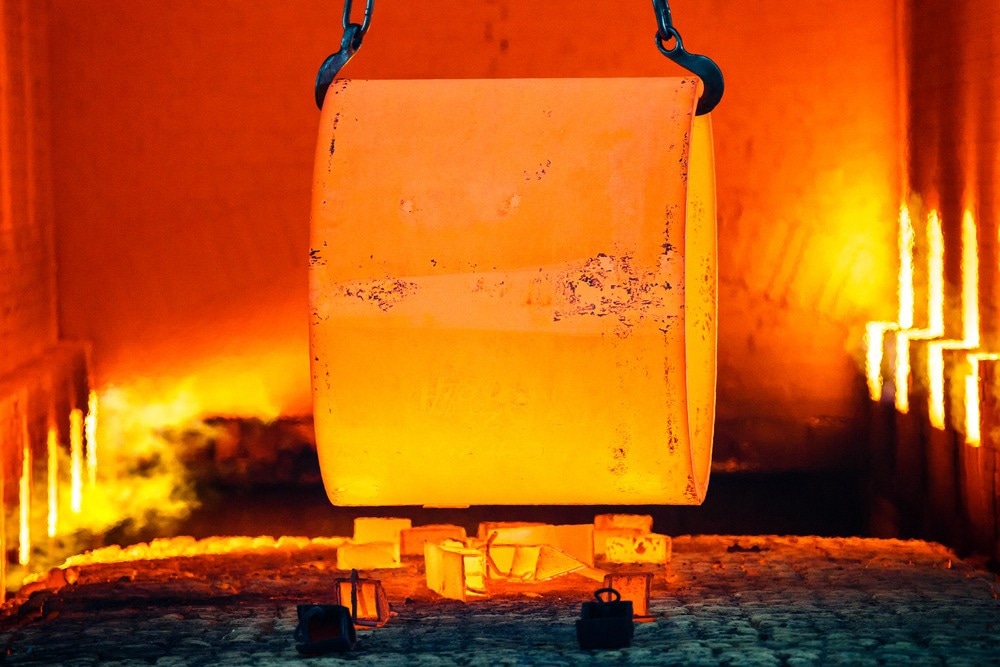This article discusses the importance of a critical cooling rate during the heat treatment of metals/alloys.

Image Credit: Picture industry/Shutterstock.com
Importance of Critical Cooling Rate
Heat treatment of an alloy or metal primarily involves controlled heating and cooling operations that are performed to alter the microstructure of the alloy/metal to realize desired mechanical properties.
The critical cooling rate in the hardening of steels is the lowest cooling rate/minimum continuous cooling rate required to form a 100% martensite structure while minimizing internal distortions and stresses.
The hardenability of steel depends on the stability of the austenite while it is cooled from 1110 oF to 930 oF, which is the upper-temperature range for austenite decomposition and the formation of relatively soft austenite decomposition products.
However, the austenite can be cooled by a continuous quench to room temperature, leading to its decomposition only below 300 oF temperature and the formation of martensite as the decomposition product. The steel becomes fully hardened in this condition.
The austenite decomposition begins in the 1110-930 oF temperature range at the critical cooling rate, which is the stability index of austenite in this temperature range. Slower critical cooling rate/deeper hardening lead to greater austenite stability in this temperature range.
The critical cooling rates of iron-carbon alloys and carbon steels are influenced by total carbon, carbon content present in the austenite, and austenitic grain size. The rate decreases continuously with an increase in total carbon for both plain carbon steel and high-purity iron-carbon alloy when the austenitic grain size and carbon content in austenite remain constant.
Additionally, a small change in austenite carbon content results in a greater impact on critical cooling rates of the lower-carbon steels/alloys compared to high-carbon steels/alloys. Alloys have a higher critical cooling rate during heat treatment compared to steels under constant austenitic carbon content, total carbon, and austenitic grain size.
Thus, alloys experience a relatively shallow hardening than steels. Critical cooling rates are also influenced by the presence of non-metallic inclusions and manganese content. Nonmetallic inclusions promote shallow hardening by facilitating austenite transformation on cooling, while manganese/chromium promotes deeper hardening by stabilizing the austenite/slowing down the austenite decomposition rate.
Moreover, the austenite reaction rate is also influenced by the distribution, size, and number of free carbides. The number of carbide particles directly varies with the increase in carbon content above the carbon saturation value in austenite at the quenching temperature under uniform size and distribution of carbide particles.
Free carbide particles can increase the reaction rates in steels containing carbon above the eutectoid value. The reaction rates continue to increase rapidly and uniformly with the increasing number of free carbide particles until reaching a value that corresponds to the total carbon value. However, any further increase in the carbide particle number does not lead to any significant effect on the critical cooling rate/hardenability.
Austenitic grain size plays a critical role in controlling critical cooling rates/hardenability, with smaller grain size steels requiring higher critical cooling rates. For instance, the critical cooling rates of 0.65-percent carbon steel decrease from 400 to 300 oF/s when the average austenitic grain size is increased from American Society for Testing and Materials (ASTM) grain number five to four.
Recent Studies on the Effect of Cooling Rates
In a study recently published in the journal Materials, researchers investigated the effects of cooling rates on mechanical properties and microstructures of carbon steel flange during tempering and quenching conditions. The objective of the study was to obtain steel flanges with high toughness and strength.
Quenching/quenching-tempering was applied at one of the nine combinations of three tempering temperatures and holding time durations. Finite element method simulation was employed to determine the cooling rates at different flange locations during quenching.
Subsequently, three locations were selected for mechanical testing based on cooling rate and the microstructures of specimens were investigated at every condition. Additionally, a Charpy impact test was performed at −46 ◦C and a hardness test and tensile test were performed at room temperature.
All specimens possessed a multiphase microstructure containing matrix and secondary phases, which decomposed under different tempering conditions. The cooling rates varied during quenching in different locations due to the non-uniform cooling in flanges.
Moreover, the area fraction of soft/hard constituent phases of the microstructure was determined by the cooling rate. Both hardness and strength were affected by the cooling rates, with faster cooling rates inducing hard phases, leading to increased strength and hardness.
Although the reduction in cooling rate during quenching decreased the strength and hardness, it did not significantly affect the low-temperature toughness. The strength and hardness were reduced, and the low-temperature toughness was increased after tempering.
Chary V-notch (CVN) impact energy was not affected significantly by the cooling rate at −46 ◦C. Tempering led to changes in the microstructure due to the decomposition of spheroidizing cementite carbide and secondary phases, which improved the CVN impact energy, strength, and hardness.
More from AZoM: What are the Different Types of Heat Treatment Furnaces?
References and Further Reading
Jo, H., Kang, M., Park, W., Kim, J., Choi, C. Y., Park, H. S., Shin, S., Lee, W., Ahn, S., Jeon, J. B. (2020). Effects of Cooling Rate during Quenching and Tempering Conditions on Microstructures and Mechanical Properties of Carbon Steel Flange. Materials, 13(18). https://doi.org/10.3390/ma13184186
Digges, T.G. (1938). Effect of Carbon on The Critical Cooling Rate Of High-Purity Iron-Carbon Alloys And Plain Carbon Steels. Journal of Research of the National Bureau of Standards, 20, 5, 571. https://nvlpubs.nist.gov/nistpubs/jres/20/jresv20n5p571_A1b.pdf
Critical Cooling Rate [Online] Available at https://www.sciencedirect.com/topics/engineering/critical-cooling-rate#:~:text=The%20cooling%20rate%20that%20just,carbon%20content%20and%20grain%20size (Accessed on 24 July 2023)
Disclaimer: The views expressed here are those of the author expressed in their private capacity and do not necessarily represent the views of AZoM.com Limited T/A AZoNetwork the owner and operator of this website. This disclaimer forms part of the Terms and conditions of use of this website.